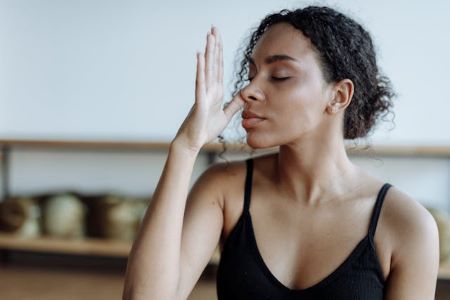Balancing Act
Scrolling through my Instagram feed, I’m met with a barrage of botanical health products all claiming to be the miracle cure to balancing my hormones.
Marketed with an effortlessly glowing (young) woman with a haute all-neutral aesthetic, for a spilt second, I find myself entranced, and curious, with a fervent belief that my life would be better if I had this product.

As my finger is poised, hovering over the ‘link in bio’, like a loaded gun, ready to fire cold-hard cash at yet another trendy “health” product, I recoil. Common-sense prevails. The centre of my intelligence kicks in. I come back into my beautifully imbalanced body, home to some of the most miraculous and complex biological processes on the planet and to what I’m being led to unfairly believe is the issue plaguing my existence: my hormones.
The internet’s exponential reach markets these products at women just like me – a curious demographic whom Mr. Algorithm deems wealthy enough, and worried enough to buy these products.
Beautifully Imbalanced
Women’s health is gaining prodigious popularity but it’s coming at a grave cost of confusion, with a confluence of talismanic tonics and powdery potions claiming to restore our balance and help us thrive.
What exactly are these hormones behaving badly that seem to have gone so worryingly awry, forcing the trillion-dollar wellness industry to propose such expensive measures?
The first thing all people with female sex hormones should know is this: balanced is a relatively nonsense term. Life is a beautiful dissemblance of ups and downs, Yin and Yang. With the good comes the bad and everything in between is just part of the ride. That’s true philosophically and it’s true of your body.

Life is a beautiful dissemblance of ups and downs, Yin and Yang. With the good comes the bad and everything in between is just part of the ride. That’s true philosophically and it’s true of your body.
Look Who’s Talking
Hormones are the body’s chemical communicators released by glands, carrying messages from one part of the body to another, using the bloodstream as a highway. Hormones can be made of either cholesterol or fat and are found in many parts of the body. But the wellness industry has taken an obscure fixation on female sex hormones, parsing their bad language as an answer to major health concerns.
Hormones live in a state of flux and change. They’re involved in a cycle, which explicitly indicates they’ll naturally rise and fall over the month. Like with all physiological factors, there are parameters for what’s considered regular levels of hormones and, if yours were to go out of this range, it might signify an underlying health issue – which you should always see a registered doctor about.
Meet Your Hormones
There are several key communicators involved in efficiently running your reproductive cycle. Some are more commonly spoken about than others but, together, they work in synergy to keep your body prepared for pregnancy.

Oestrogen
Possibly the most commonly discussed, oestrogen is a dominant female sex hormone. It’s also produced by men, but it plays a more significant role in the female body.
Oestrogen is involved in all our transformative life stages – from puberty to pregnancy – and it plays a pivotal role in the overall health of our bodies. Oestrogen is instrumental in:
- Regulating bone strength and density
- Heart, and brain function
- Protecting the skin from DNA damage that causes ageing.
- Regulating cholesterol levels.
- Bladder control
- Mucous production
- Hair health and growth
Produced mainly in the ovaries, oestrogen can also be synthesised by other areas of the body, such as the adrenal glands and fat cells. We usually produce oestrogen in these locations when we aren’t ovulating (releasing an egg each month for fertilisation).
As well as the physical influence of oestrogen, it has many cognitive relationships too, affecting memory function and libido. We have several types of oestrogen, each involved in particular stages of our cycles. Levels vary throughout our menstrual cycles and, understandably, they start to drop off after menopause.
Progesterone
Progesterone is the second most talked about female hormone, largely because of its integral role in pregnancy. Typically rising after conception, it’s also key in regulating your period.
Produced in the ovaries after an egg is released, levels of progesterone rise with an aim for pregnancy to happen after a mature egg is released by your ovaries. Progesterone also stimulates glandular development and development of new blood vessels – harvesting a good environment for a fertilised ovum to implant.
Levels drop if an ovum isn’t fertilised and doesn’t implant in your uterus. This causes the lining of the uterus (the endometrium) to breakdown and your period to start.
Prostaglandins
Prostaglandins are less talked about but that doesn’t mean they don’t have a big physical impact. Hormone-like compounds, prostaglandins are made from fats and behave like hormones do. What’s unique about prostaglandins is their transient and varied effects. They attach to different sites and act differently depending on where they attach in the body.
Prostaglandins aren’t released from glands like hormones are. Instead, they are made by a number of the body’s tissues. They play a wide variety of roles in the body and often work in opposing ways, such as:
- Dilating and constricting blood vessels (vasodilation and vasoconstriction).
- Opening and closing airways.
- Contracting and relaxing the gastrointestinal (GI) tract.
- Promoting uterine contractions in both menstruation and pregnancy.
Prostaglandins have a short life span and don’t last long in the body. This means they only influence behaviours in other close by cells. Prostaglandin receptors can be found in the uterus during both your monthly period and pregnancy. It’s thought that they encourage uterine cramping and create painful period experiences. Prostaglandins may also influence increased bowel movements during your period.
Hormonal Phases
The menstrual cycle can affect your whole body as hormone levels fluctuate during the different phases of your cycle. The length of menstrual cycles can vary but are typically spoken about on a linear 28-day timescale. For most people, 21 – 35 days is normal.

Period: Days 1 – 7*
Your period happens at the beginning of your follicular phase, on roughly days 1 – 7. During your period, hormone levels generally plateau. Prostaglandin receptors may be high as the uterine lining breaks down. During this first phase of your cycle, you’ll most likely experience general period symptoms – largely physical – along with some mood changes and fatigue.
Proliferative Phase: Days 7 – 14*
Also happening within the follicular phase, the proliferative phase immediately follows your period and carries you through to ovulation (usually halfway through your cycle). Proliferative means ‘to grow quickly’ and a surge of hormones will occur, primarily oestrogen, as the ovaries prepare to release a matured egg. Most women will experience more pleasant symptoms during proliferation – glowing skin, shiny, soft hair, and lots of energy. This owes to oestrogen peaking and driving you to get out there and get pregnant!
Ovulation: Circa Day 14*
Ovulation occurs halfway through the follicular phase, usually around day 14 depending on your actual cycle length. As an egg reaches maturation, it’s released from the ovary, travels down the fallopian tube, hoping to hook up with a sperm for fertilisation. Some people experience ovulation pain and other symptoms, such as headaches and nausea, as oestrogen levels peak and fall, and progesterone begins to rise. Sharp twinges and dull aches in one side are common and should ease in 1 – 2 days.
Secretory Phase: Days 14 – 28*
Our secretory phase occurs within the luteal phase and refers to the process your body goes through when an egg hasn’t been fertilised and prepares for a period. Progesterone will rise over the course of this phase, preparing for a fertilised egg.
If no fertilised egg implants in the uterus, progesterone will taper off and the uterine lining will shed, leaving the body as your period.
Most women will experience pre-menstrual symptoms at some point during this phase, including mood changes, fatigue, headaches, acne, abdominal bloating and tension, IBS, breast tenderness, and disrupted sleep patterns until their period begins and the cycle starts over.
Your Yoga Prescription
Everybody is unique and every menstrual cycle will have different symptoms alongside fluctuating hormones. But there are many tools available to help you more easily ride the waves of your cycle – including yoga.
Yoga is effective in many ways. Although it can’t physically impact your hormones, it can provide you with relief from associated symptoms and support you in ascertaining a healthy lifestyle that supports overall health.

Riding The Period Plateau
As oestrogen levels fall during your period, you might experience mood changes, menstrual cramps, abdominal distention, period poops, wind, and constipation as well as bBack ache, joint pain, and tense muscles. There’s potentially a lot to contend with during this time.
To help settle an irritated heart or anxious mind, focus on pranayama techniques – particularly Equalised Breathing (Samavritti Pranayama). Settling the soul and stilling the mind, Samavritti stimulates the parasympathetic nervous system, invoking inner-calm.
Gentle asana sequences, like moon salutations (Chandra Namaskara), repeated a few times also have a calming effect. This repetition, known as Jappa Jappa, is thought to centre the mind in a similar way to meditation, albeit connected to physical movement. Repeated sequences can deliver a huge therapeutic effect as the mind homes in, and we are absorbed by the moment. For more physical symptoms, like abdominal distention and irritated bowels, supine twists are your friend. Gently increasing blood flow throughout the abdomen, lying supine twists (Supta Matseyendrasana), have the added benefit of the earth supporting your body. When you engage in a standing or seated twist, abdominal muscles are engaged to hold up your torso. Lying down, you don’t have that battle, but still garner the benefits of the twist – also beneficial for aches and pains in the lumbar spine and the hips.
Achey legs benefit from deep stretches like Happy Baby (Ananda Balasana), Wide Legged Forward Fold (Prasarita Padottanasana), and Extended Child Pose (Utthita Balasana), which all serve to stretch out the muscles and tendons of the legs. Holding yin style for an extended duration, (around 1 – 2 minutes should do), will work deeper into the tissues for added relief.
Perfect Proliferation
Full of energy and cultivating more creativity, physical symptoms are most likely at their lowest point during the proliferation phase as oestrogen peaks and your body begins a process of regeneration. But with heightened energy comes an over-stimulated mind, possibly distracted and unable to focus.
As with your period phase, more systematic sequences, like Sun Salutations (Surya Namaskar), or Ashtanga-inspired flows may serve to bring a flighty mind back down to earth through the process of repetition (Jappa Jappa).
A Pain In The Side
During ovulation, a degree of abdominal pain and distention may present itself for a short period. Embrace your lying supine twists for gentle release. Abdominal compression in Knees to Chest Pose (Apanasana), may also feel soothing to ovulation pain.
Aside from the surprise twinges, ovulation actually has surprising physical benefits, and you may find you’re more flexible and elastic around this time. It’s thought that hormones relating to ovulation, like progesterone, influence flexibility in our ligaments – known as ligamentous laxity. While your instincts may tell you to push a bit further or finally face challenge asanas like Bird of Paradise (Svarga Dvijasana), approach with caution, so as not to overstretch outside the body’s regular range of motion.
Yoga Nidra and deep breathing with visualisations are beneficial to distract from sharp pains, encouraging the body to enter a deep rest state and detract from the pain in your side.
You may still experience high levels of energy around your ovulation day, so allow the body and mind this time to settle with grounding postures that are challenging, expending excess energy, while inviting focus and connection with the moment. Triangle Posture (Trikonasana), Extended Side Angle Utthita Parsvokanasana), and Warrior I (Virabhadrasana I) are all good choices for stretching out your sides, increasing blood flow to painful points, and centring a deleting mind.
The Final Sliding Scale
In the final yard dash to your next period, oestrogen drops and progesterone peaks. But, if a fertilised egg is absent, your body prepares for your next period. Pre-menstrual symptoms like headaches, breast tenderness, and mood changes start ramping up as progesterone peaks, falling just before the period starts.
Mood changes, like increased irritability, might benefit from balancing poses. Not something usually associated with either symptom, balances promote introspection through their prerequisite for deep focus. The more technical nature of balances like Lord of The Dance (Natajarasana), and Half Moon (Ardha Chandrasana), have exact alignment requirements and require patience and dedication to achieve, and an irritated mind might be that determined to breakthrough and help you achieve these balances.
Heart opening postures like Supported Fish (Matsyasana), or Camel (Ustrasana), help increase blood flow to the chest area, soothing tender breasts. Avoid prone heart openers, like Anahatasana (Melting Heart Pose), which place pressure on the chest area.
In the constant barrage of health fads flooding our social media feeds, the allure of achieving hormonal balance through aesthetically pleasing means is tempting. However, it’s crucial to remember that our bodies, with their intricate hormonal interplays, are not issues needing trendy fixes but wonders of nature deserving our understanding and respect. As we traverse the peaks and valleys of our hormonal cycles, a grounded approach emerges: the importance of making informed choices, questioning one-size-fits-all solutions and adopting supportive practices like yoga over chasing after an elusive ideal of perfection.

True balance doesn’t come packaged in a product; it’s discovered by attentively listening to and honouring the complex symphony of our biology.
Main – Photo by Becca Tapert on Unsplash




